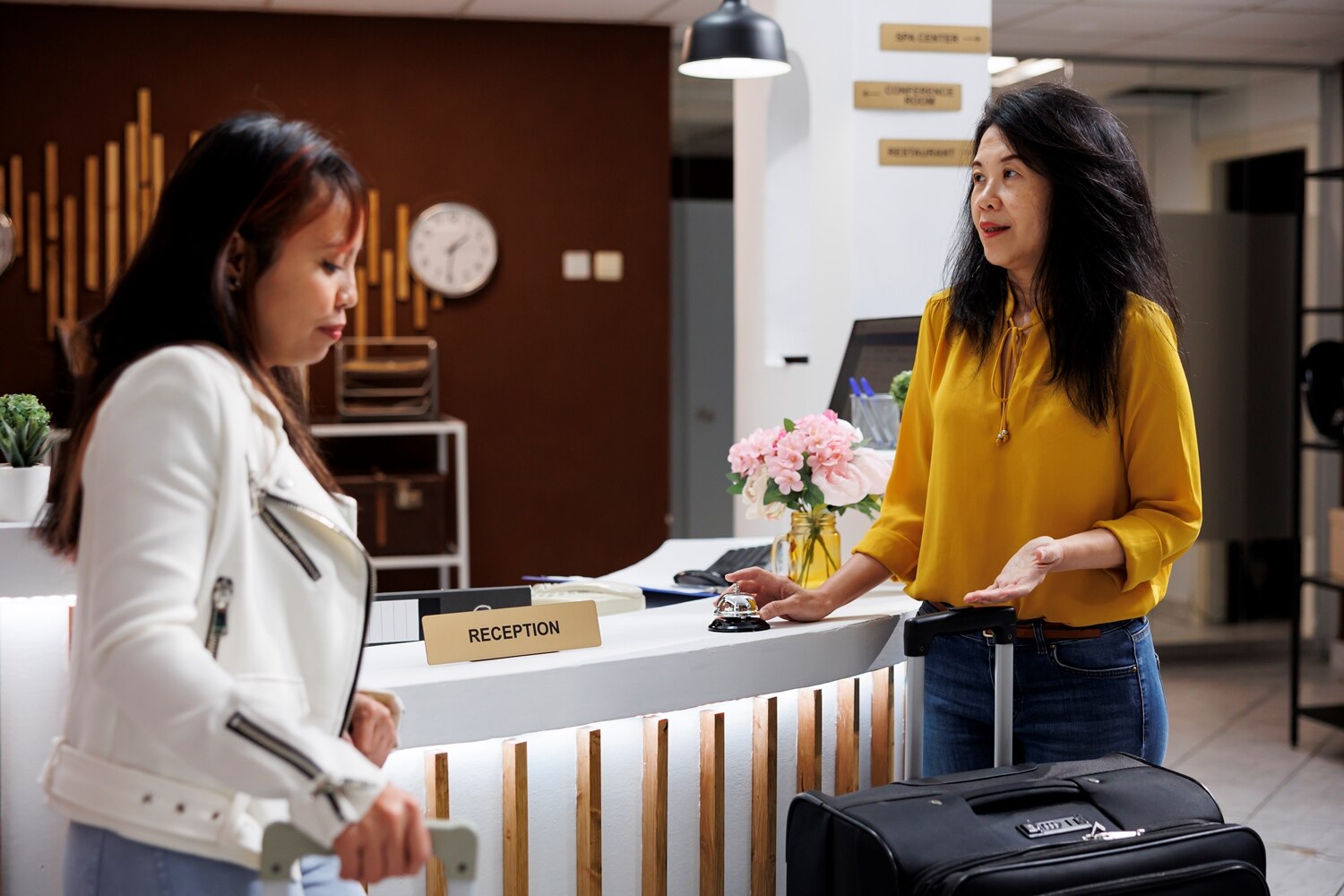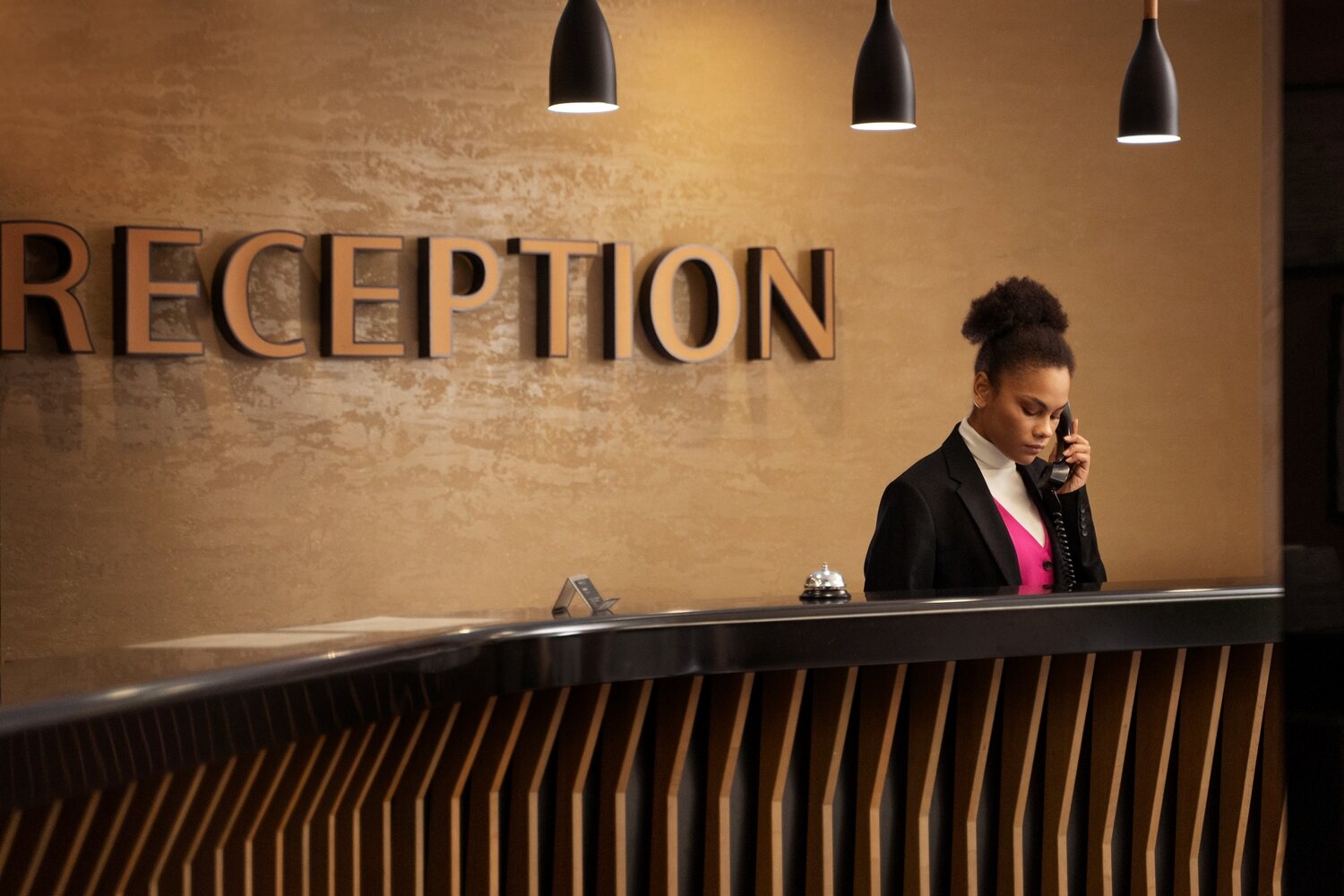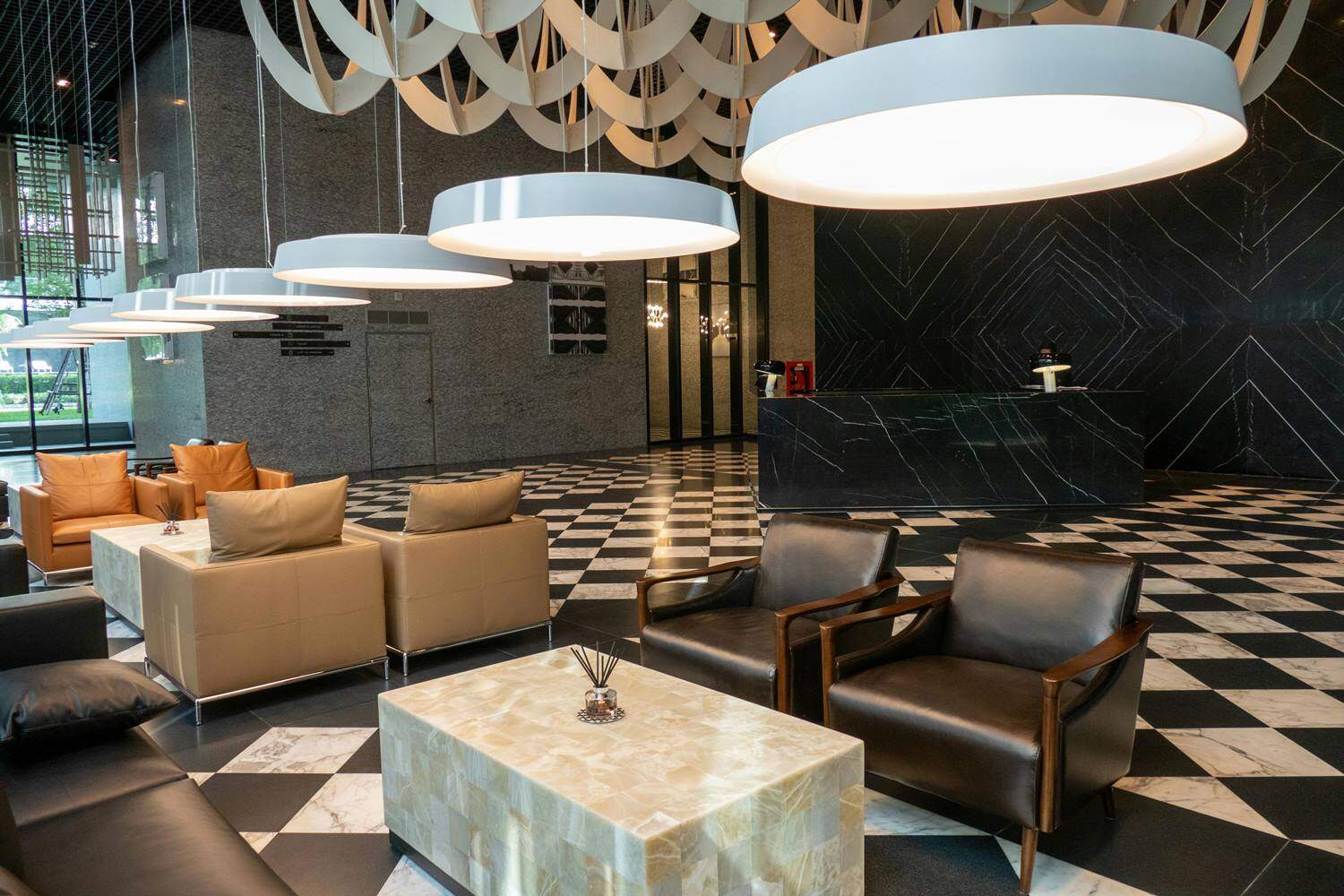Managing conflicts in a hotel setting requires a combination of effective communication, empathy, and problem-solving skills.
Ready to improve conflict management in your hotel? Discover our tailored services designed to help you handle conflicts efficiently and maintain a harmonious environment.
Here are some strategies that can be employed:
Active listening strategy to manage conflicts in a hotel with Examples
Active listening is a powerful strategy for managing conflicts in a hotel setting. It involves fully concentrating, understanding, responding, and then remembering what is being said by a guest. Here’s a deeper look at how it works, its benefits, and how to use it, along with examples:
How It Works
- Full Attention: The listener gives their complete attention to the speaker, often nodding or giving non-verbal cues to show engagement.
- Understanding: The listener tries to understand the content and emotion behind the words, asking clarifying questions if necessary.
- Responding Appropriately: After the speaker finishes, the listener summarizes what was said to confirm understanding and responds empathetically.
- Memory: The listener remembers key points of the conversation, which is crucial for resolving the conflict and for future interactions.
Benefits
- De-escalation of Conflict: By feeling heard, guests are more likely to calm down and become more receptive to solutions.
- Building Trust: Guests feel valued and respected, which builds trust and loyalty towards the hotel.
- Accurate Problem Identification: Active listening helps in understanding the real issues behind a guest’s complaint.
- Improved Service: Insights gained from active listening can be used to improve services and prevent future conflicts.
How to Use Active Listening
- Non-Verbal Cues: Maintain eye contact and nod occasionally.
- Avoid Interruptions: Let the guest speak without interruptions.
- Clarify: Ask open-ended questions to clarify points.
- Reflect Back: Paraphrase what the guest said to show understanding.
- Empathize: Show empathy towards the guest’s situation.
- Remember Key Points: Take mental or physical notes of important details.
Examples
Example 1: Problem & Solution
- Problem: A guest complains about the noise level from nearby construction disturbing their sleep.
- Active Listening Strategy: The hotel staff listens attentively, acknowledges the inconvenience, and clarifies the specific times when the noise is most bothersome.
- Solution: The staff offers to move the guest to a quieter room and informs them about the construction schedule. They also provide complimentary earplugs and a free breakfast as a gesture of goodwill.
Example 2: Problem & Solution
- Problem: A guest is upset about an error in their billing, with charges for services they didn’t use.
- Active Listening Strategy: The staff member listens without interrupting, summarizes the guest’s concern to ensure understanding, and expresses empathy for the frustration caused.
- Solution: The staff member reviews the bill, corrects the error, and explains the updated charges clearly. They apologize for the mistake and offer a discount on their next stay to make up for the inconvenience.
Through active listening, hotel staff can not only resolve conflicts more effectively but also enhance the overall guest experience, turning potentially negative situations into opportunities for positive engagement and customer loyalty.
Empathy strategy to manage conflicts in a hotel with Examples
Show empathy towards the guest’s situation. Acknowledging their feelings and frustrations can go a long way in de-escalating a situation.
Empathy is a crucial strategy for managing conflicts in a hotel. It involves understanding and sharing the feelings of another person, particularly in situations of distress or dissatisfaction. Here’s a detailed look at how empathy works in conflict resolution, its benefits, how it can be used effectively, and some examples:
How It Works
- Understanding Feelings: Empathy requires hotel staff to put themselves in the guest’s shoes and understand their emotions and perspective.
- Verbal Acknowledgment: It involves acknowledging the guest’s feelings verbally, showing that their emotions are recognized and valid.
- Appropriate Response: Empathizing with the guest leads to a more tailored and sensitive response to their problem.
Benefits
- Reduces Hostility: Showing empathy can calm an agitated guest, as they feel understood and valued.
- Builds Rapport: It fosters a sense of connection and trust between the guest and the hotel staff.
- Encourages Openness: Guests are more likely to express their true concerns and provide useful feedback when they feel empathized with.
- Prevents Escalation: Empathy can prevent conflicts from escalating by addressing the emotional aspect of the conflict.
How to Use Empathy
- Listen Actively: Listen to the guest’s complaint without interrupting to understand their perspective fully.
- Acknowledge Feelings: Use phrases like “I understand why you feel upset” to show you recognize their emotions.
- Body Language: Maintain appropriate body language that conveys concern and attentiveness.
- Validate Their Experience: Even if the issue seems minor, validate the guest’s experience.
- Follow-Up with Action: Show that their feelings have been taken seriously by following up with concrete actions.
Examples
Example 1: Problem & Solution
- Problem: A guest is distressed because their room is not ready upon arrival, despite a guaranteed check-in time.
- Empathy Strategy: The receptionist acknowledges the inconvenience and distress caused, saying, “I completely understand how frustrating this must be for you, especially after your long journey.”
- Solution: The guest is offered a comfortable seating area, complimentary drinks, and regular updates while their room is being prepared. They also receive a complimentary upgrade for the inconvenience.
Example 2: Problem & Solution
- Problem: A guest complains about a noisy air conditioner in their room that disrupted their sleep.
- Empathy Strategy: The staff member empathizes with the guest’s discomfort, saying, “It must have been very difficult to get a good night’s rest with that noise. I’m so sorry about this.”
- Solution: The staff offers to move the guest to a different room immediately and checks the new room in advance to ensure it’s quiet. As a gesture of apology, the guest is given a voucher for a free breakfast.
Through empathy, hotel staff can effectively manage conflicts by understanding the emotional aspect of the guest’s complaints, leading to more satisfactory resolutions and enhancing the overall guest experience.
Stay Calm and Professional strategy to manage conflicts in a hotel with Examples
The “Stay Calm and Professional” strategy is vital in managing conflicts in a hotel setting. This approach involves maintaining composure, thinking clearly, and interacting in a respectful and professional manner during tense situations. Here’s an exploration of how this strategy works, its benefits, how to use it effectively, and examples of its application:
How It Works
- Maintaining Composure: Staying calm involves controlling emotional responses and avoiding reactive behavior.
- Professional Demeanor: This includes using a polite tone, formal language, and maintaining a neutral but friendly facial expression.
- Clear, Logical Thinking: Keeping calm allows staff to think clearly and logically, focusing on solutions rather than getting caught up in the heat of the moment.
Benefits
- De-escalation of Tensions: A calm approach can help to de-escalate emotions and prevent the situation from worsening.
- Credibility and Respect: Professional behavior earns respect from guests and can enhance the credibility of the staff and the hotel.
- Effective Problem Solving: Calmness allows for better decision-making and problem-solving capabilities.
- Positive Work Environment: This approach promotes a positive and controlled work environment, which is beneficial for both staff and guests.
How to Use the Strategy
- Deep Breathing: Use deep breathing techniques to maintain calm.
- Pause Before Responding: Take a moment before responding to collect your thoughts.
- Use a Calm Tone: Speak in a calm, even tone, even if the guest is upset.
- Focus on Facts: Stick to the facts of the situation rather than emotional aspects.
- Avoid Taking Offense: Remember that the guest’s frustration is usually about the situation, not personal.
- Seek Support if Needed: If the situation escalates, don’t hesitate to involve a supervisor or manager.
Examples
Example 1: Problem & Solution
- Problem: A guest angrily complains about an incorrect charge on their bill.
- Stay Calm and Professional Strategy: The staff member remains calm, listens without interrupting, and speaks in a steady, respectful tone.
- Solution: After reviewing the bill, the staff member explains the charges clearly, corrects any errors, and apologizes for the confusion. The calm handling of the situation helps to soothe the guest’s anger.
Example 2: Problem & Solution
- Problem: A guest is upset and raises their voice about the lack of hot water in their room.
- Stay Calm and Professional Strategy: The staff member maintains composure, acknowledges the issue professionally, and does not mirror the guest’s agitation.
- Solution: The staff member quickly arranges for a technician to fix the issue and offers the guest access to another room for showering in the meantime. They also provide a complimentary spa voucher for the inconvenience.
Staying calm and professional is a key strategy in conflict management within hotels, as it helps to stabilize the situation, allows for effective problem-solving, and maintains a positive image of the hotel and its staff.
Clear Communication Strategy to manage conflicts in a hotel with Examples
The Clear Communication Strategy is an essential tool for managing conflicts in a hotel. This strategy emphasizes the importance of conveying information in a straightforward, unambiguous manner. It involves both listening and speaking effectively to ensure mutual understanding between hotel staff and guests.
How It Works
- Articulate Speech: Using simple, clear language to explain situations or solutions.
- Active Listening: Paying close attention to what the guest is saying, without interrupting, and clarifying points when necessary.
- Non-Verbal Cues: Utilizing appropriate body language, eye contact, and facial expressions to reinforce the spoken message.
- Confirmation: Asking questions and repeating back what you’ve heard to confirm understanding.
Benefits
- Prevents Misunderstandings: Clear communication reduces the chances of misunderstandings which can escalate conflicts.
- Efficient Problem Resolution: Clear articulation of problems and solutions speeds up the resolution process.
- Builds Trust and Credibility: Guests are more likely to trust staff who communicate clearly and confidently.
- Improves Guest Satisfaction: Effective communication leads to better customer service experiences.
How to Use the Strategy
- Use Simple Language: Avoid jargon or overly technical terms that might confuse the guest.
- Be Specific: Provide specific information rather than vague statements.
- Ensure Understanding: Ask the guest if they understand or have any questions.
- Be Honest: Communicate any limitations or constraints honestly.
- Follow Up: Provide written or verbal follow-ups to ensure clarity and consistency.
Examples
Example 1: Problem & Solution
- Problem: A guest is confused about the hotel’s parking charges.
- Clear Communication Strategy: The staff member clearly explains the parking fee structure, including any exceptions or discounts that may apply. They use simple terms and ensure the guest understands each aspect.
- Solution: After the explanation, the staff member asks if the guest has any further questions to ensure complete understanding. The guest appreciates the clarity and feels more satisfied with the service.
Example 2: Problem & Solution
- Problem: A guest complains that the room is not as described on the website.
- Clear Communication Strategy: The staff member listens to the guest’s concerns, then clearly and politely explains the discrepancy between the website’s description and the actual room features.
- Solution: The staff member offers a room that matches the guest’s expectations more closely, explaining the features of the new room in detail. They also apologize for any misunderstanding caused by the website description.
Clear communication in conflict management within hotels is crucial in ensuring that both staff and guests are on the same page. This strategy helps in quickly resolving issues, reduces the likelihood of further misunderstandings, and enhances the overall guest experience.
Find the Root Cause strategy to manage conflicts in a hotel with Examples
The “Find the Root Cause” strategy in conflict management is crucial, especially in a hotel setting where guest satisfaction is paramount. This approach involves identifying the underlying issues that are causing the conflict, rather than just addressing the symptoms or the immediate problem. Here are some steps involved in this strategy, along with examples:
1. Listen to All Parties Involved: Begin by listening to everyone involved in the conflict. This helps in understanding different perspectives and gathering necessary information.
- Example: If a guest is upset about their room not being cleaned on time, listen to both the guest’s complaint and the housekeeping staff’s explanation.
2. Ask Probing Questions: Use open-ended questions to dig deeper into the issue. This can reveal underlying problems that might not be immediately apparent.
- Example: Ask the housekeeping staff questions like, “What challenges are you facing in maintaining the cleaning schedule?”
3. Analyze the Situation: Look at the situation as a whole, considering all factors that might have contributed to the conflict.
- Example: Discover that the housekeeping staff is short-handed or that there was a misunderstanding about the cleaning schedule.
4. Identify the Root Cause: Based on the information gathered, identify the core issue that led to the conflict.
- Example: The root cause might be inadequate staffing or a lack of clear communication about cleaning times.
5. Develop Solutions: Brainstorm and implement solutions that address the root cause, not just the symptoms.
- Example: Hire additional staff, revise the cleaning schedule, or improve communication methods with guests about room service times.
6. Monitor and Follow-Up: After implementing solutions, monitor the situation to ensure the conflict doesn’t recur and that the solution is effective.
- Example: Regularly check with the housekeeping team and guests to ensure that the new measures are working and rooms are being cleaned as per the schedule.
7. Document and Learn: Keep a record of the conflict and how it was resolved. This can be a valuable learning tool for preventing similar conflicts in the future.
- Example: Document the incident in a management logbook, noting the steps taken to resolve the issue and any changes made to prevent a recurrence.
Offer Solutions strategy to manage conflicts in a hotel with Examples
The “Offer Solutions” strategy in conflict management is particularly effective in a hotel setting, where resolving issues promptly and satisfactorily is essential to maintain customer satisfaction and service quality. This approach involves proposing practical and mutually acceptable solutions to the parties involved in the conflict. Here’s how this strategy can be applied, with examples:
1. Understand the Conflict: First, get a clear understanding of the conflict by listening to all parties involved. This helps in identifying their needs and concerns.
- Example: A guest complains about the noise coming from a neighboring room, disrupting their sleep.
2. Brainstorm Possible Solutions: Think of different ways to address the conflict. These solutions should aim to meet the needs of all involved parties as much as possible.
- Example: Offer the guest a room change, provide them with earplugs, or speak to the occupants of the noisy room to request quieter behavior.
3. Present Options to the Parties: Offer the identified solutions to the parties involved in the conflict. It’s important to explain the benefits of each option.
- Example: Explain to the guest the options of moving to a quieter room or the measures you’ll take to ensure the noise is reduced.
4. Negotiate and Agree on a Solution: Encourage the parties to discuss the options and come to an agreement on the best solution.
- Example: The guest might choose to move to a different room if the noise issue cannot be immediately resolved.
5. Implement the Solution: Once a solution is agreed upon, act on it promptly. This shows commitment to resolving the issue and maintaining service quality.
- Example: If the guest chooses to move rooms, quickly arrange for their luggage to be transferred and ensure the new room is up to their standards.
6. Follow-Up: After implementing the solution, follow up with the guest to ensure that their issue has been resolved to their satisfaction.
- Example: Check in with the guest after they have settled into the new room to confirm that they are comfortable and the issue has been resolved.
7. Document and Evaluate: Keep a record of the conflict and how it was resolved. This can help in evaluating the effectiveness of the solution and in training staff.
- Example: Note the incident and resolution in a logbook and review it in staff meetings to discuss how similar situations can be handled in the future.
Follow Up strategy to manage conflicts in a hotel with Examples
The “Follow Up” strategy in conflict management is a critical step in ensuring that the resolution of a conflict is effective and lasting, especially in the context of a hotel where guest satisfaction is a top priority. This approach involves checking back with the parties involved after a solution has been implemented to ensure that the issue has been resolved satisfactorily and to prevent similar issues in the future. Here’s how this strategy can be effectively implemented, with examples:
1. Confirm Resolution of the Issue: After a solution has been implemented, check back with the guests or staff involved to ensure that the issue has indeed been resolved to their satisfaction.
- Example: If a guest had complained about a malfunctioning air conditioner and it was fixed, check with the guest to ensure the room is now at a comfortable temperature.
2. Seek Feedback: Ask for feedback on how the situation was handled. This shows that you value the opinions of those involved and are committed to continuous improvement.
- Example: Ask the guest if they were satisfied with the speed and effectiveness of the maintenance response, and if there’s anything else that could be improved.
3. Address Any Remaining Concerns: If there are any lingering issues or dissatisfaction, address these promptly. This may involve offering additional solutions or compensation.
- Example: If the guest is still unhappy about the initial discomfort, consider offering a discount on their current stay or a voucher for future services.
4. Document the Process: Keep detailed records of how the conflict was managed and resolved. This documentation can be useful for future reference and for training purposes.
- Example: Record the details of the issue, the steps taken to resolve it, and the outcome in a management logbook or a customer relationship management (CRM) system.
5. Evaluate and Learn: Use the experience to evaluate the effectiveness of your conflict resolution process. Identify any lessons learned and consider how similar issues can be prevented or better managed in the future.
- Example: If several guests have complained about air conditioning issues, consider scheduling regular maintenance checks to prevent similar problems.
6. Communicate with Staff: Share the outcome and any lessons learned with the staff. This helps in building a knowledgeable and proactive team capable of handling future conflicts more effectively.
- Example: Discuss the incident in a staff meeting, emphasizing the importance of prompt maintenance and effective communication with guests.
Training Staff strategy to manage conflicts in a hotel with Examples
The “Training Staff” strategy in conflict management is essential in a hotel environment, where the quality of service and customer satisfaction are paramount. This approach involves equipping hotel staff with the necessary skills and knowledge to handle conflicts effectively and professionally. Here’s how this strategy can be implemented, along with examples:
1. Regular Training Sessions: Conduct regular training sessions for staff on conflict resolution, customer service, and communication skills.
- Example: Organize workshops or seminars led by experienced professionals in hospitality management to teach staff about effective communication, empathy, and problem-solving in conflict situations.
2. Role-Playing Scenarios: Use role-playing exercises to simulate common conflict scenarios that staff might encounter in the hotel. This helps staff practice their response in a controlled environment.
- Example: Set up a scenario where a guest is unhappy about their room not being ready on time, and have staff practice how to handle the situation and appease the guest.
3. Developing Empathy and Listening Skills: Emphasize the importance of empathy and active listening in understanding and resolving guest concerns.
- Example: Train staff to listen attentively to guest complaints, validate their feelings, and show understanding, which can often de-escalate a situation quickly.
4. Empowerment and Decision-Making: Empower staff by giving them the authority to make certain decisions to resolve conflicts promptly.
- Example: Allow front desk staff to offer complimentary upgrades or discounts within a certain limit to resolve guest issues without needing to consult management for every decision.
5. Understanding Cultural Differences: Provide training on cultural sensitivity and understanding, as hotels often serve guests from diverse backgrounds.
- Example: Educate staff about common cultural differences and customs to prevent misunderstandings and unintentional offense.
6. Stress Management Techniques: Teach staff stress management techniques to help them remain calm and composed during challenging interactions.
- Example: Offer training on deep breathing exercises or provide access to a quiet relaxation space for staff to use during breaks.
7. Feedback and Continuous Improvement: Encourage staff to provide feedback on the training programs and use this feedback to continuously improve the training content and methods.
- Example: After each training session, ask staff to fill out a survey on what they found helpful and what could be improved.
8. Creating a Supportive Environment: Foster a work environment where staff feel supported and know they can turn to their managers or colleagues for help when dealing with difficult situations.
- Example: Establish a mentorship program where experienced staff members guide and support newer employees in handling guest interactions.
Implementing Feedback strategy to manage conflicts in a hotel with Examples
The “Implementing Feedback” strategy in conflict management is vital in a hotel setting, where guest feedback can be a powerful tool for improvement and conflict resolution. This approach involves actively soliciting, analyzing, and acting upon feedback from guests and staff. Here’s how this strategy can be effectively applied, with examples:
1. Soliciting Feedback: Encourage guests and staff to provide feedback on their experiences and any conflicts they encountered.
- Example: Use comment cards, online surveys, or direct conversations to gather feedback from guests about their stay, specifically asking about any issues they faced and how they were resolved.
2. Analyzing Feedback: Regularly review the feedback to identify common complaints or areas for improvement.
- Example: If multiple guests mention that the check-in process is slow and frustrating, this could indicate a need for changes in staffing or procedures at the front desk.
3. Taking Action Based on Feedback: Implement changes based on the feedback to resolve the identified issues.
- Example: In response to feedback about slow check-in, you might streamline the process, add more staff during peak times, or introduce a digital check-in option.
4. Training and Development: Use the feedback to inform training and development for staff, focusing on areas where conflicts are most frequently reported.
- Example: If guests frequently complain about poor communication from the housekeeping staff, include communication skills and customer service in your next staff training session.
5. Communicating Changes: Let guests and staff know what changes have been made in response to their feedback. This demonstrates that you value their input and are committed to improvement.
- Example: Post updates on your hotel’s website or send emails to past guests informing them of the new, more efficient check-in process.
6. Follow-Up on Implemented Changes: After implementing changes, follow up to ensure they are effective in resolving the issues. Continue to gather feedback on these changes.
- Example: Monitor the efficiency of the new check-in process and ask guests for their feedback on it.
7. Creating a Culture of Continuous Improvement: Foster a culture where feedback is seen as valuable and where continuous improvement is a key goal.
- Example: Recognize and reward staff who effectively implement feedback and contribute to resolving conflicts or improving services.
8. Documenting and Reviewing Changes: Keep records of the feedback received and the actions taken in response. Review these periodically to assess their effectiveness and make further adjustments as needed.
- Example: Maintain a log of guest feedback and the changes made, reviewing it monthly to assess impact and areas needing further improvement.
Mediation strategy to manage conflicts in a hotel with Examples
The “Mediation” strategy in conflict management is a critical approach in a hotel setting, particularly for resolving complex disputes where direct negotiation between the parties involved has not been effective. This strategy involves introducing a neutral third party to facilitate a resolution. Here’s how this approach can be effectively applied in a hotel environment, with examples:
1. Identifying the Need for Mediation: Recognize situations where mediation might be more effective than direct negotiation. This is usually the case when conflicts escalate or when there are communication barriers between the parties involved.
- Example: If a long-staying guest has an ongoing dispute with the hotel over billing discrepancies that hasn’t been resolved through normal channels.
2. Choosing a Neutral Mediator: Select a mediator who is impartial and perceived as neutral by all parties involved. This could be someone from within the hotel who is not directly involved in the conflict or an external professional mediator.
- Example: For a dispute between a guest and a department (like housekeeping), a manager from a different department could act as the mediator.
3. Facilitating Open Communication: The mediator should facilitate a discussion where all parties are given an equal opportunity to express their viewpoints in a controlled and respectful environment.
- Example: Arrange a meeting where the guest and the billing department can discuss the issue in the presence of the mediator, ensuring both sides are heard.
4. Identifying Common Ground and Interests: The mediator helps the parties identify common interests and areas of agreement, which can be a foundation for building a mutually acceptable solution.
- Example: The mediator helps both the guest and the hotel recognize their shared interest in maintaining a good relationship and finding a fair resolution.
5. Encouraging Problem Solving: The mediator encourages and guides the parties towards collaborative problem solving, rather than taking sides or imposing a solution.
- Example: The mediator prompts each side to propose possible solutions to the billing dispute and discusses the feasibility and acceptability of these options.
6. Agreeing on a Resolution: The goal is to reach a resolution that is acceptable to all parties. The mediator assists in crafting this agreement and ensuring it is clear and comprehensive.
- Example: Arrive at an agreement where the billing errors are corrected, and the guest receives an appropriate adjustment or compensation.
7. Follow-Up: After the mediation, it’s important to follow up to ensure the agreement is implemented and to address any subsequent issues that may arise.
- Example: The mediator checks in with both the guest and the billing department a week later to confirm that the agreed-upon solution has been enacted and is satisfactory.
8. Documentation and Learning: Document the process and outcome of the mediation for future reference and learning. This can help improve the mediation process and conflict resolution approaches within the hotel.
- Example: The mediator or a designated staff member records the details of the dispute, the mediation process, and the resolution, which is then reviewed by management to refine conflict resolution strategies.
Policy and Procedure Clarity strategy to manage conflicts in a hotel with Examples
The “Policy and Procedure Clarity” strategy in conflict management is crucial in a hotel setting. It involves ensuring that all policies and procedures are clearly communicated and understood by both staff and guests. This clarity helps in preventing misunderstandings and conflicts. Here’s how this strategy can be implemented effectively in a hotel, with examples:
1. Clear Documentation of Policies and Procedures: Ensure that all hotel policies and procedures are documented in a clear, concise, and accessible manner.
- Example: Have a detailed handbook for staff outlining procedures for common scenarios like guest complaints, room booking issues, and emergency situations.
2. Effective Communication to Guests: Make sure that hotel policies are communicated to guests at various touchpoints, such as during booking, check-in, and in the rooms.
- Example: Include key policies like cancellation terms, check-in/check-out times, pet policies, and smoking rules in the booking confirmation email and in a welcome booklet in each room.
3. Training Staff on Policies: Regularly train hotel staff on existing policies and any updates to ensure they are well-informed and can communicate these policies effectively to guests.
- Example: Conduct training sessions whenever a new policy is introduced or an existing one is updated, and use role-playing exercises to help staff learn how to explain these policies to guests.
4. Signage and Informational Displays: Use signage and informational displays around the hotel to remind guests of important policies.
- Example: Place signs in relevant areas, such as a “No Smoking” sign in non-smoking areas, or information about pool hours near the pool.
5. Easy Access to Policy Information for Guests: Ensure that guests can easily find information about hotel policies, whether it’s through printed materials, the hotel’s website, or a guest services directory.
- Example: Have a section on the hotel’s website dedicated to FAQs, covering key policies and procedures.
6. Consistent Enforcement of Policies: Apply hotel policies consistently and fairly to all guests. This avoids perceptions of bias or unfair treatment.
- Example: If a guest requests a late checkout, the decision should be based on the hotel’s policy and availability, applied consistently with previous cases.
7. Feedback and Review Mechanisms: Regularly gather feedback from staff and guests on how policies are working and review them for any necessary adjustments.
- Example: If guests frequently complain about the early closure of the fitness center, consider reviewing and possibly extending the hours based on guest feedback.
8. Clear Communication During Conflicts: When a conflict arises, refer back to the relevant policies in a clear and respectful manner to help resolve the issue.
- Example: If a guest is unhappy about being charged for a late cancellation, politely explain the cancellation policy that was communicated at the time of booking.
9. Procedures for Exceptions: Have clear procedures for handling exceptions to policies, ensuring that any deviations are justified and documented.
- Example: If a guest faces an emergency and needs to cancel last minute, have a procedure in place for waiving the cancellation fee in such exceptional circumstances.
Technology Utilization strategy to manage conflicts in a hotel with Examples
By employing these strategies, hotels can effectively manage conflicts, ensuring that guests leave with a positive impression even after a negative incident.



























